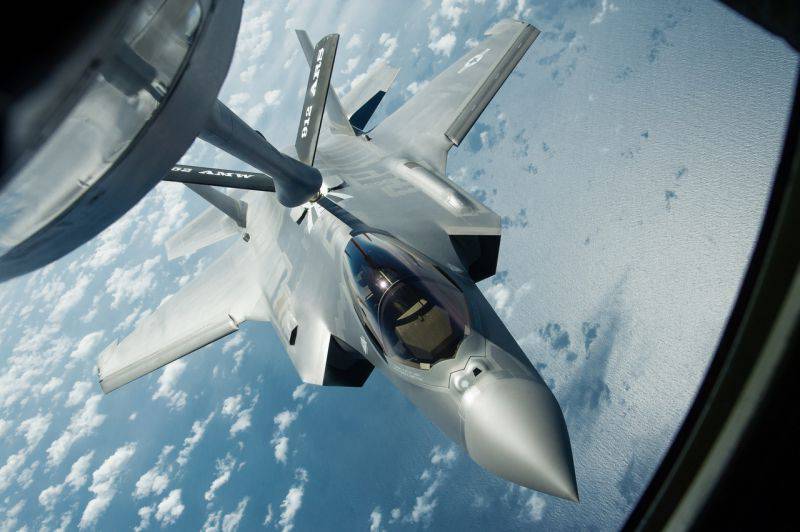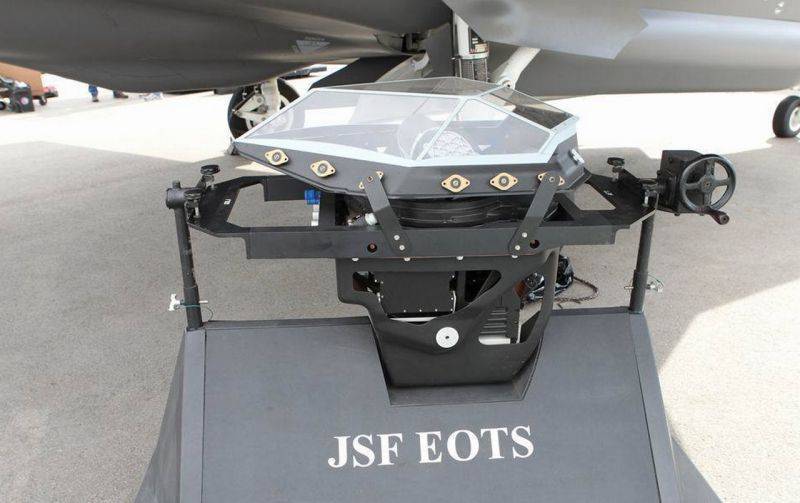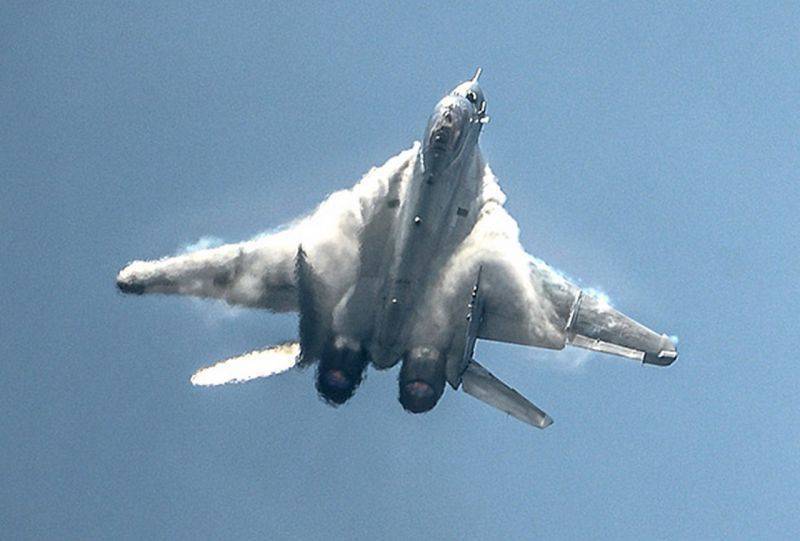F-35 Fighting Laser: Will Lightning Change Air War Tactics?

Despite the significant perfection and novelty of the F-35A F-10, which is more productive and efficient than on various modifications of the F-16C and even F-22A fighter jets, less powerful AN / APG-81 radar, inferior maneuverability compared to F-15C, The combat radius of everything in 1100 km, a small number of internal suspension points - all this does not allow the Lightning II to be a full-fledged tactical fighter of the 5 generation
Since the inception of one of the most "high-profile" programs "Lockheed Martin", the concept of the F-35 fighter jets has been made huge bets, because the combat vehicle had to completely replace the F-16 multi-purpose tactical fighter aircraft fleet, with a large number of its modifications and "blocks", and also deck F / A-18C / D (E / F), outperforming them not only in terms of onboard avionics equipment, but also in basic aerodynamic qualities and LTH of the airframe; as a result, it never happened. According to the results of numerous military exercises of the US Air Force on its territory, as well as in the UK, the low flight performance of the F-35A glider, which in its maneuverability was not only inferior to the more "smart" British "Typhoon" with a composite wing and fuselage, was quickly confirmed. standard versions of the F-15C and F-16C generation "4 / 4 +", the successful technological base of which was developed at the end of 60-x - the beginning of 70-x. Complaints of low maneuverability came even from experienced pilots of the US Air Force, which automatically equates the capabilities of the F-35 melee air combat to the performance of the old F-4E.
The superior potential for network-centric air warfare was also not confirmed, where all the avionics of the link / squadron aircraft must operate in a single multi-frequency tactical information transfer system such as Link-16; Now all the advanced F-15E / SE, F-16C Block60 and F / A-18E / F / G aircraft have these parameters, which are equipped with the same airborne radar with AFAR that have a synthetic aperture mode when scanning the earth / water surface.
It is worth noting a very interesting feature: the most important trump card of the F-35, the low radar signature of the airframe (EPR aircraft near 0,2 - 0,3 m 2), makes it necessary to carry missile-bomb armament on the suspensions in the internal weapons bays, which can accommodate no more than 4 guided missiles air-to-air AIM-120C-7 "AMRAAM" for the task of winning air superiority. This is a very small number of missiles, given that modern EW fighters from developed countries are capable of reducing the effectiveness of missiles with active radar seeker by more than 50%, a vivid example is the Russian EIB Khibiny complex with attached modules of individual and group protection . In order to preserve the proper ammunition of the F-35 air wing in the United States, they even recently decided to use the F-15C / E modifications as heavy carriers of air-to-air missiles to support the F-35, which makes it impossible to refer it to a full-fledged 5. generation of tactical combat aircraft. Placing weapons on additional external suspension nodes will certainly lead to an increase in the EPR of the fighter to 0,5 - 0,8 m2, which corresponds to machines of the 4 ++ generation.
All the aspirations of Lockheed Martin specialists have broken about the harsh reality with the advent of the radio and optoelectronic appearance of the Russian MiG-35С multi-purpose light fighter, which can go into mass production at the end of 2016 of the year. The deeply refined "Twenty-Nine" deservedly received two advantages in its transitional generation, although there are even 6-generation technologies. The so-called system of optical-electronic detection of attacking missiles, represented by two compact optical-electronic complexes - VS-OAR and NS-OAR, the upper and lower hemispheres, respectively, received the most attention. These complexes are capable of detecting most of the known air-to-air, ground-to-air, and air-to-ground missiles that threaten the MiG-35 itself or friendly air and ground units. The detection of large-scale missiles of the type RIM-67 or MIM-104 is made at a distance of 45 - 50 km, missiles of the type "AMRAAM" - 35 km; BC- / NS-OAR is a high-resolution passive optical warning system, due to which missiles with an infra-red homing head (passive type) can be detected and the aircraft is completely protected from the enemy’s sudden attack.
The optical-electronic complex EOTS ("Electro-Optical Targeting System") installed on the F-35 Block 4, has so far confirmed only the possibility of working on large warm-contrast targets of the "launching ICBM" type, which does not allow it to be ranked as the most tactically important unit Avionics at the time of the defense of the fighter from a missile attack the main means of theater of operations by the enemy.

The main disadvantage of the EOTS optical-electronic complex is that its main sensors are installed in a special turret under the nose of the fuselage, which seriously limits the detection of close threats in the upper hemisphere from the fighter
The problem with the incompatibility of F-35 with many modern threats to the theater and the bustle around the low performance of the aircraft forced the manufacturer to resort to completely unconventional technical solutions that not only significantly increase the cost of the JSF program, but also cannot guarantee a significant increase in combat capabilities.
Unexpected news October 6 came from the internet resource defenseone.com. The publication, citing Lockheed Martin, announces the development of a combat modular fiber-optic laser with an 0,4 energy yield (40%) with a total power from 0,06 to 0,12 MW. It is assumed that with such weapons F-35 will be able to achieve overwhelming superiority over any existing and even developed fighter. Meanwhile, and here the Americans, who have set up further illusions about the "star wars", run into significant problems related both to the limits and limitations of the operation of the laser weapons, and with the imperfection of the carrier itself, because the capabilities of the aircraft as an aircraft remain the same.
It is known that the power of a fiber-optic laser for Lightning II will be about 80 - 100 kW, the laser beam will be formed from several channels in each fiber-optic conductor. The laser will definitely have high efficiency, but power in 100 kW will not be enough to work effectively on medium and large air targets, and for physical reasons, depending on the natural composition of the atmosphere, you can count the mass.
F-35 is not a large enough carrier to install a combat laser with a large large-area mirror, as this will have a worse effect on the mediocre performance of the aircraft. A small mirror (up to two dozen centimeters in size) will not provide an output power that allows you to realize the capabilities that Lockheed Martin hopes for. In addition, the physical expansion of the light cone of radiation (the so-called diffraction divergence law) will play a huge role, as a result of which even the X-NUMX-kilowatt F-120 beam with a diameter of 35 cm (output) at a distance of 5 km will have a spot diameter of 10 radiation m and the 0,5 radiation power density W / cm25,5, which will be enough for serious overheating of the aircraft’s electronic equipment during long-term exposure from one direction, but taking into account the fact that the fighter is a combat vehicle that constantly maneuvers and There are fast pitch and roll turns, the exposure of one fuselage section will be very short-term, which will not allow serious overheating or “burning” any on-board equipment or airframe trimming materials, especially frontal ones, which are most suitable for high-temperature flight modes at 2 - 2,0M speeds.
At a distance of 100 km, the situation is even more complicated: the beam turns into a spot with a diameter of 5 m and a power density of just 0,25 W / cm 2; and this is without taking into account 65% of the power losses of the beam during the passage of large distances in the upper layers of the troposphere / lower layers of the stratosphere (11 - 13 km), where the atmosphere is quite dense. Such a beam is capable of only slightly heating the components of a fighter or a UAV by only a few tenths of a degree while keeping the base of the radiation cone on the target for a long time, which, firstly, will not affect the performance of the AIRO, and secondly, it is practically impossible to apply to maneuvering aircraft fighter / UAV type vehicles. Ie, at distances 10 and more kilometers, the laser weapon of the fighter will only be able to influence the operation of the optical-electronic sighting systems, while the main “combat active”, the radar complex, will maintain the 100% combat potential of the irradiated fighter.
In long-range air combat, the absorptive capacity of the atmosphere will play a decisive negative effect on the energy of the laser beam, which will “lose power”, passing through droplets of water vapor and dust molecules present even at considerable heights, and as you know, all modifications of the F-35 fighter have the practical ceiling in 16100 m, which is 3 — 4 km lower than that of such aircraft as the Su-35C or F-22A: even a cirrus cloud will create an already insuperable barrier for an already weakened beam, which will make it ineffective even against optical sensors in targeting enemy aircraft.
F-35A, having an EPR 0,3 m, will be detected and “captured” by modern aviation radar H011M Bars or H001VE (Su-30СМ and Su-27СМ fighters) at 80 - 100 km, because of which the American fighter jets are X-NUMXCM and Su-35CM-XNUMXM, or X-NUMXME fighter jets, or X-NUMXME. to maneuver in order not to be shot down during the very first, over-the-horizon identification by the radars of our fighter-interceptors, and maneuvering is the impossibility of using a laser installation, the elevation and azimuthal viewing areas of which are strictly limited by a rigidly fortified turret, which by no means would There is a wide range, because even more spoil the aerodynamics of the F-XNUMX.
The situation is similar in the air combat, "dog dump". Although at distances less than 8 km, the combat laser will pose some threat to our fighters by imposing close combat on Lightning, our pilot will be completely confident of victory over the American laser pointer, which for the same reason limits the use of azimuth and elevation will not even be able to hold the beam on our fighter even for a fraction of the time; low maneuverability will not allow him to keep the necessary laser angles for a long time in a direction favorable to the enemy fighter.
As a result, it can be concluded that the use of combat laser weapons in the performance of air-to-air class tasks is an absolutely unpromising direction, especially against fighter aircraft, in military transport aviation there are also many ways to defend against an American combat laser, one of which can be special cylinders with infrared aerosols and other chemical barriers to the passage of a powerful laser beam.

Super-maneuverability, more sophisticated, and undoubtedly a full-range, opto-electronic "stuffing" MiG-35С, in addition to the more powerful on-board radar complex with AFAR "Zhuk-A", will allow our fighter to completely surpass the 2 times more expensive American competitor with useless laser on board
Compensation of tactical and technical deficiencies of the F-35 family of fighters due to the use of laser weapons in the Earth’s atmosphere is a losing move of the famous Lockheed Martin company, because a laser can show its full potential only at altitudes above 40 km (in near space), that for the current aviation will not be available for a long time.
Information